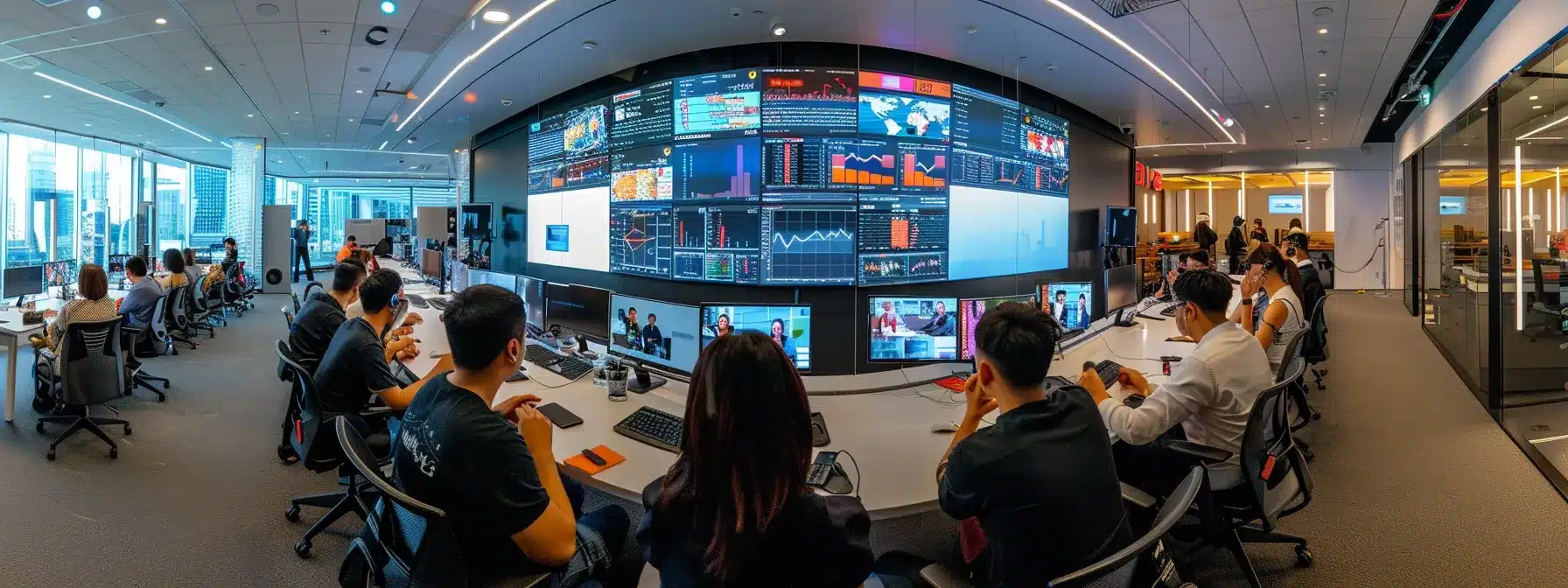
Stay up to date on the latest digital marketing topics.
News & Trends

Mastering User Experience vs SEO for Large Enterprises
User Experience vs SEO: Finding the Right Balance
In today’s digital landscape, finding the right balance between User Experience (UX) and is crucial for creating an effective online presence. Both elements play vital roles in determining a website’s success; however, they often come with competing priorities. On one hand, UX focuses on creating an intuitive and enjoyable environment for users, ensuring they can navigate a site easily and access the information they need without frustration. This involves aspects such as page load speed, mobile responsiveness, and clear site architecture.
A great user experience not only encourages longer site visits but also promotes higher engagement and conversion rates.On the other hand, SEO is centered around optimizing a website to improve its visibility in search engine results, which is essential for driving organic traffic. This encompasses keyword research, on-page optimization, link-building strategies, and keeping up with the ever-evolving algorithms of search engines. While a website might be designed with the user in mind, neglecting SEO can result in low visibility, ultimately undermining the efforts to create a user-friendly platform. Conversely, focusing solely on SEO can lead to a site that prioritizes keywords and backlinks at the expense of user experience, resulting in higher bounce rates and lower user satisfaction.
Understanding the Intersection of User Experience and SEO

User experience (UX) in a digital context focuses on how visitors interact with a website, influencing overall satisfaction. SEO plays a crucial role in enhancing online visibility, driving local search traffic while addressing issues such as duplicate content. Effective UX can boost site speed and responsiveness being key factors, particularly for mobile optimization. This section will explore these critical elements and their impact on revenue generation.
Defining User Experience in a Digital Context
User experience (UX) in a digital context encompasses how users navigate and interact with a website, significantly influencing their satisfaction and engagement levels. A user-friendly interface not only fosters trust but also enhances scalability, enabling businesses to adapt and grow in the competitive landscape. When websites prioritize UX, they often see an improvement in metrics that SEO agencies monitor, such as bounce rates and time on site, which ultimately impacts search engine optimization rankings.
Effective UX integrates elements that cater to customer service, ensuring visitors can easily find information and complete desired actions. For instance, a seamless checkout process in an e-commerce website can lead to higher conversion rates, directly benefiting revenue generation. Additionally, optimizing for search engine optimization requires a focus on intuitive navigation and relevant content delivery, making it essential for digital marketing strategies aimed at improving visibility and attracting targeted traffic.
The Role of SEO in Enhancing Online Visibility
SEO is integral to enhancing online visibility, as it directly influences how a website ranks on search engines. A well-executed strategy focuses on relevant keywords, including long tail keywords, which target specific user queries and increase the likelihood of attracting qualified traffic. By optimizing web pages for these terms, businesses can improve their chances of being found by potential customers actively searching for their products or services.
The connection between SEO and conversion rate optimization is evident when a website provides a satisfying user experience. When visitors find relevant content quickly and navigate a well-structured web page seamlessly, they are more likely to engage with the site and complete desired actions, such as making a purchase. This synergy not only boosts overall visibility but also significantly impacts revenue, reinforcing the need for businesses to balance user experience with effective search engine optimization practices.
How User Experience Influences SEO Rankings
User experience (UX) significantly impacts SEO rankings by influencing customer engagement. When a website effectively addresses user intent through intuitive design and relevant content, it fosters a more satisfying experience that keeps visitors on the site longer. This increase in dwell time, along with lower bounce rates, signals search engines that the content is valuable, which can improve overall rankings.
harnessing data integrity in UX can help fine-tune marketing efforts, such as influencer marketing campaigns. By analyzing data from user interactions, businesses can experiment with different layouts or content types, ensuring they align with customer expectations. This iterative process not only enhances user satisfaction but also supports
strategies, driving more qualified traffic and ultimately boosting conversion
Importance of Site Speed and Responsiveness
Site speed and responsiveness are critical components of both user experience and SEO. Research indicates that a delay of just a few seconds in page load time can significantly detract from customer experience, leading to increased bounce rates and decreased engagement. Ensuring a streamlined workflow on the website enables users to access information quickly, allowing them to complete desired actions, such as purchasing products or signing up for newsletters, without frustration.
Moreover, optimizing site speed contributes to greater brand awareness by enhancing how users perceive a business’s professionalism and efficiency. Effective copywriting plays a role here as well, ensuring that messaging remains compelling and relevant while being quickly accessible. A responsive design provides a seamless experience across all devices, fostering a positive relationship with customers that can lead to higher conversion rates and improved search engine optimization rankings.
The Impact of Mobile Optimization on User Experience
Mobile optimization is critical for enhancing user experience, as a significant portion of consumers access websites from their smartphones. A web developer’s role in creating responsive designs that adapt to various screen sizes ensures that users engage seamlessly with content. Additionally, the collaboration between design and allows for quick information retrieval, ensuring that mobile users can find what they need without unnecessary delays.
Furthermore, effective navigation structures such as simplified sitemaps can improve the mobile experience by guiding consumers to relevant information swiftly. An optimized mobile site creates a positive impression and encourages users to interact with the brand, ultimately impacting conversion rates. Therefore, prioritizing search engine optimization is essential for businesses aiming to strike a balance between user experience and SEO effectiveness.
Key Components of Effective SEO Strategies for Large Enterprises
In the landscape of digital marketing, large enterprises face unique challenges when it comes to implementing effective Search Engine Optimization (SEO) strategies. Key components of successful SEO for these organizations include comprehensive keyword research, strategic content creation, and robust technical optimization. Keyword research goes beyond identifying high-traffic terms; it involves understanding the intent behind search queries to align content with the needs of target audiences. Large enterprises can leverage advanced tools to analyze search trends, competitor strategies, and user behavior, thereby ensuring they adopt a data-driven approach that caters to the nuances of their industry.

Aligning User Intent With SEO Practices
Aligning user intent with SEO practices requires a keen understanding of how search algorithms prioritize content. Organizations must analyze user behavior and adjust their strategies accordingly to ensure that their websites satisfy visitor needs. For instance, businesses may consider outsourcing parts of their SEO efforts to fine-tune their approach, leveraging expert insights to optimize content based on real user queries.
Understanding the current landscape of search optimization is crucial for reducing bounce rates and improving user retention. By creating content that directly addresses user questions or pain points, organizations can enhance user engagement and encourage longer visits. This strategy not only boosts but also fosters a loyal customer base that finds true value in the information provided.
Utilizing Analytics to Improve User Engagement
Utilizing analytics is essential for corporations aiming to improve user engagement and optimize their SEO strategies. By interpreting personal data from website traffic, organizations can identify user behavior patterns and preferences, leading to targeted content creation. Incorporating machine learning technologies enhances this analytical approach, allowing businesses to adjust their strategies in real-time and create more relevant experiences for visitors.
Integrating User Feedback Into SEO Strategy
Integrating user feedback into an SEO strategy allows businesses to create a more effective content strategy that resonates with their audience. SEO companies can use insights from customer interactions to refine landing pages, ensuring the content aligns with user needs and preferences. By employing a that tracks user behavior, organizations can pivot their approach swiftly, promoting services that directly address current interests and concerns.
User input serves as a valuable resource for continuous improvement and optimization. Monitoring feedback on site elements, such as navigation and content relevance, enables enterprises to adjust their strategies promptly. This proactive approach not only enhances user experience but also boosts search engine optimization performance, establishing a strong foundation for maintaining competitive advantage in a crowded marketplace.
Creating Structured Content for Optimal SEO
Creating structured content plays a vital role in optimizing SEO, as it enhances how search engines interpret a website’s information. By implementing clear headings, relevant keywords, and a logical flow, businesses can significantly improve accessibility for users navigating through a web browser. For example, conducting thorough keyword research enables organizations to identify terms that resonate with their target audience, thus increasing web traffic by aligning content with user intent.
Furthermore, well-structured content is crucial for effective affiliate marketing strategies. When content is organized and easily digestible, it allows visitors to find desired information quickly, enhancing their overall experience. This approach not only drives user engagement but also supports higher conversion rates, making it essential for enterprises aiming to balance user experience and SEO effectiveness.
Enhancing Site Navigation for Better User Journey
Enhancing site navigation is pivotal for improving usability and ensuring a smooth customer journey on digital platforms. A well-structured navigation system allows users to find desired content quickly, which ultimately leads to increased satisfaction and engagement. This user-centric approach not only boosts the likelihood of conversion but also positively impacts a website’s performance on search engine results pages, enhancing visibility in organic search results.
For enterprises aiming to establish robust leadership in their respective markets, prioritizing easy-to-use navigation is essential. Effective navigation reduces customer frustration, leading to longer session durations and lower bounce rates. By utilizing analytics to assess user behavior, businesses can identify opportunities to streamline navigation, making it intuitive and relevant, thereby aligning with both user expectations and search engine optimization best practices.
Strategies for Balancing User Experience and Search Optimization
In the ever-evolving digital landscape, achieving a harmonious balance between user experience (UX) and search engine optimization (SEO) is crucial for website success. Professionals understand that a site prioritizing SEO can often compromise user experience, leading to high bounce rates and diminished user engagement. Conversely, an overly simplistic user-friendly interface may fail to satisfy search engine algorithms. To strike the right balance, it’s essential to implement strategies that focus on both dimensions simultaneously rather than treating them as mutually exclusive.
One effective strategy is to adopt a user-centered design approach that incorporates SEO principles at its core. This can involve conducting thorough keyword research to understand user intent and integrating these keywords seamlessly into high-quality, relevant content. Additionally, maintaining a fast loading speed, optimizing images, and ensuring mobile responsiveness can enhance the user experience while simultaneously satisfying SEO criteria. Moreover, employing clear navigation and a structured layout not only improves accessibility for users but also aids search engines in effectively crawling and indexing the site. By concentrating on these interconnected strategies, businesses can create a website that delights users while also achieving higher search engine rankings, paving the way for long-term engagement and success.

Prioritizing User-Centric Design in SEO Plans
Prioritizing user-centric design within SEO plans enables businesses to create an engaging online experience while enhancing visibility. By focusing on efficiency in website structure and content layout, organizations can ensure that visitors find relevant information easily, ultimately reducing bounce rates. When businesses invest in competitor analysis to understand their audience’s needs, they can tailor their marketing strategy to address specific pain points, which can lead to higher conversion rates.
Implementing user-centric design principles on enterprise SEO platforms not only improves aesthetics but also drives better performance metrics. A well-designed interface encourages users to interact longer with the site’s content, fostering a sense of trust and satisfaction. For companies looking to refine their approach, analytics can reveal essential insights into visitor behavior, guiding modifications that further enhance user experience. To discover how these strategies can benefit a business, potential clients are encouraged to reach out and contact us for tailored solutions.
Leveraging a/B Testing to Measure User Interaction
By presenting two variations of a web page to users, organizations can gather data on engagement levels, such as time spent on the page and navigation paths, which directly influences perceptions of credibility. These insights allow businesses to make informed decisions grounded in actual user behavior, leading to enhancements that improve overall performance in search engine rankings.
Effective testing should also consider SEO elements such as hreflang tags for multilingual sites, ensuring that the right content reaches the intended audience. Implementing these tactics alongside an enterprise SEO audit can reveal critical user interaction trends while ensuring nofollow links and similar strategies do not hinder visibility. Ultimately, balancing user needs with SEO tactics through A/B testing can drive better outcomes and foster lasting relationships with visitors.
Implementing SEO-Friendly Design Elements
Implementing SEO-friendly design elements is crucial for ensuring content is both user-focused and search engine optimized. By establishing a clear hierarchy within the website, information becomes more accessible, allowing users to navigate efficiently. Incorporating visuals, such as infographics, not only enhances engagement but also aids in retaining information, making the content more valuable to the audience.
Moreover, integrating social media elements into the website design can enhance brand reputation and drive traffic, creating a seamless experience for users. Effective content creation practices, paired with thoughtful design, allow businesses to establish a compelling online presence that resonates with visitors while boosting search visibility. This balance ensures that user experience and SEO efforts work in harmony, ultimately driving better engagement and conversions.
Building Content That Balances Engagement and Optimization
Building content that effectively balances engagement with SEO requires a clear understanding of user behavior and expectations. Conducting a gap analysis can reveal areas where enterprise content may lack relevance or depth, enabling businesses to refine their messaging to better connect with their target audience. By incorporating relevant anchor text strategically throughout the content, organizations can enhance navigation while simultaneously improving search engine optimization, ensuring that users find the information they seek quickly and easily.
Furthermore, leveraging enterprise SEO tools allows businesses to monitor and adapt their content strategies based on user interactions and feedback. This data-driven approach enables marketers to create targeted content that resonates with user needs, enhancing both engagement and optimization. By addressing user pain points and aligning content with relevant search engine optimization terms, companies can foster a more meaningful connection with their audience while achieving better search engine rankings.
Employing Technical SEO to Enhance User Experience
Employing technical SEO is vital for enhancing user experience while also addressing critical aspects of website performance. Regular audits, for instance, can identify areas needing improvement, including site speed and mobile responsiveness, which are essential for retaining users. Additionally, implementing structured data improves how search engines interpret site content, leading to better visibility and user engagement.
Link building remains a cornerstone of technical SEO that directly influences user experience. By fostering high-quality backlinks, businesses enhance their authority, which can improve visibility in search engine rankings. Moreover, integrating social media marketing strategies can amplify engagement and drive traffic, ensuring that users not only find the content but also have an engaging experience while navigating the website.
Common Challenges in Balancing User Experience and SEO

Balancing user experience with search engine optimization presents several challenges. Avoiding SEO practices that compromise user satisfaction requires careful consideration of site infrastructure, ensuring that optimization efforts do not detract from the overall user journey. Aesthetic design often conflicts with functionality, necessitating a trade-off that can affect visitor engagement. Additionally, managing multiple stakeholder perspectives in large enterprises can complicate these decisions, alongside overcoming resistance to change in established SEO practices. Adapting to evolving search engine algorithms while maintaining a focus on user experience introduces further risk and demands ongoing attention to keyword research and best practices.
Avoiding SEO Practices That Compromise User Satisfaction
To avoid SEO practices that compromise user satisfaction, businesses must remain vigilant about how optimization efforts affect website usability. For instance, excessive keyword stuffing can degrade the quality of content, leading to a frustrating experience for users seeking valuable information. Striking the right balance between effective content marketing strategies and enhancing user engagement requires thoughtful project management, ensuring that search engine optimization techniques support—not hinder—the return on investment journey.
Incorporating content management systems can help streamline the optimization process while maintaining user-centric design principles. By focusing on clear and relevant information, businesses can create a logical table of contents that guides users through their website seamlessly. Understanding target audience, or the needs and preferences of the audience, is essential for bypassing practices that detract from satisfaction and instead fostering a positive browsing experience.
Addressing Trade-Offs Between Aesthetic Design and Functionality
In web design, striking a balance between aesthetic elements and functionality is crucial for small businesses aiming to enhance user experience while optimizing for SEO. For example, an appealing visual layout can capture the attention of a target audience, but if the site is sluggish or difficult to navigate, users may quickly lose interest. Therefore, a practical approach would involve prioritizing a streamlined design that maintains visual appeal without sacrificing load times or ease of use, ensuring that essential processes like email marketing sign-ups remain straightforward for visitors.
For enterprises utilizing enterprise SEO services, addressing trade-offs between aesthetics and functionality often involves iterative testing and data analysis. Implementing user feedback can reveal how design choices impact engagement and conversion rates, ultimately guiding adjustments that enhance both visual appeal and overall site efficiency. By focusing on combining artistic elements with user-centric strategies, businesses can create a website that not only attracts potential customers but also supports effective navigation and improved visibility in search engine results.
Managing Multiple Stakeholder Perspectives in Large Enterprises
In large enterprises, managing multiple stakeholder perspectives can introduce significant complexity when aligning user experience with SEO initiatives. Different departments often have varying priorities; for instance, marketing may prioritize engaging content while IT focuses on the technical aspects, such as CSS and site speed on subdomains. This disparity can lead to misunderstandings and hinder a cohesive strategy that promotes both user satisfaction and search engine visibility.
Overcoming Resistance to Change in Established SEO Practices
Overcoming resistance to change in established SEO practices requires a strategic approach that emphasizes collaboration and education. Stakeholders may be hesitant to adapt due to familiarity with existing processes or a fear of disrupting what seems to be working. Hosting workshops or training sessions that showcase the benefits of an updated SEO strategy can foster an understanding of how innovative practices can lead to better user experience and, ultimately, improved search engine results page.
Furthermore, illustrating successful case studies can help alleviate concerns. For instance, presenting data from organizations that revamped their SEO strategies, resulting in increased traffic and engagement, can build trust among team members. By demonstrating the tangible benefits of embracing change and aligning SEO efforts with user experience, organizations can create an environment conducive to experimentation and growth, addressing both user needs and search engine optimization effectively.
Adapting to Changing Search Engine Algorithms Without Sacrificing UX
Adapting to changing search engine algorithms presents a significant challenge for businesses aiming to maintain a strong user experience while optimizing for visibility. As algorithms evolve, website owners must stay informed about new ranking factors that influence search engine optimization performance. For instance, factors such as mobile-friendliness and page load speed have become increasingly important; hence, organizations should continuously assess and refine their websites to meet these requirements without compromising user satisfaction.
Balancing algorithm updates with user experience involves a proactive approach to website management. For example, an organization can implement regular audits to identify areas needing improvement, ensuring that layout changes do not negatively impact navigation. By focusing on both SEO compliance and usability, businesses can effectively adapt to new search engine expectations while enhancing the overall user journey, leading to improved engagement and conversion rates.
Measuring Success in User Experience and SEO Integration

Key Performance Indicators (KPIs) are essential in evaluating user experience by assessing aspects such as site navigation efficiency and user satisfaction. Tracking SEO metrics that reflect user engagement, like dwell time and click-through rates, provides valuable insights into content effectiveness. Utilizing user behavior analytics informs strategic adjustments, while regular site audits ensure SEO and UX compliance. Finally, creating comprehensive content marketing services.
communicates these successes to stakeholders, highlighting the impact of effective integration.
Key Performance Indicators for User Experience
Key performance indicators (KPIs) for user experience are essential for organizations looking to measure the effectiveness of their digital platforms. Metrics such as average session duration and pages per session allow businesses to assess how engaged users are while navigating their websites. By analyzing these KPIs, companies can identify areas that may need improvement, ensuring they maintain a user-friendly interface that encourages prolonged interaction and search engine optimization.
Another valuable KPI is the bounce rate, which indicates the percentage of visitors who leave a site after viewing only one page. A high bounce rate may signal that content is not resonating with users or that navigation is suboptimal. Monitoring this metric allows businesses to make informed adjustments, ultimately balancing user experience with search engine optimization strategies that drive organic traffic and enhance overall performance.
Tracking SEO Metrics That Reflect User Engagement
Tracking SEO metrics that reflect user engagement is essential for determining how well a website meets visitor needs. Key metrics such as average session duration, pages per session, and click-through rates provide insights into user behavior and content effectiveness. By monitoring these metrics, businesses can identify areas that require enhancements to align better with user expectations, ultimately driving both satisfaction and improved search engine optimization rankings.
Moreover, understanding user engagement through these metrics allows organizations to make informed decisions about content strategies and website design. For example, if analytics reveal a high bounce rate on specific pages, this signals that the content may not resonate with visitors or that navigation could be optimized. Addressing these pain points not only improves user experience but also strengthens the overall performance of search engine optimization efforts, ensuring that both aspects work harmoniously to achieve business objectives.
Utilizing User Behavior Analytics to Inform Strategy
User behavior analytics serve as a vital tool for organizations aiming to enhance both user experience and search engine optimization performance. By closely monitoring metrics such as page views, click-through rates, and user pathways, businesses can gain insights into how users interact with their sites. This data enables them to identify potential friction points or areas where users may disengage, allowing for targeted modifications that can improve retention and satisfaction.
Conducting Regular Site Audits for SEO and UX Compliance
Conducting regular site audits for SEO and user experience (UX) compliance is essential to maintaining a balance between the two. By assessing key performance indicators such as site speed, mobile responsiveness, and navigation efficiency, businesses can identify areas for improvement that enhance both visibility and user satisfaction. For instance, a company might discover high bounce rates on certain pages, prompting a redesign that streamlines navigation or improves content relevance, thereby addressing user needs more effectively. boost your visibility with Google My Business optimization.
Moreover, audits facilitate the refinement of both SEO strategies and UX design by revealing how well a website performs under current search engine algorithms. Organizations can gauge the effectiveness of their content by analyzing user behavior data, ensuring that it not only aligns with SEO best practices but also resonates with visitors’ expectations. This proactive approach enables businesses to adapt to changing needs and preferences, fostering a responsive online presence that attracts and retains users while achieving optimal search rankings.
Creating Reports to Communicate Success to Stakeholders
Creating comprehensive reports that effectively communicate the success of integrating user experience and SEO strategies is critical for retaining stakeholder trust. These reports should highlight key performance indicators like user engagement metrics, conversion rates, and site speed improvements, linking these metrics to specific strategies implemented. Clear visualization of data trends can help stakeholders understand the correlation between enhanced user experience and improved search rankings, fostering support for future initiatives.
Moreover, including actionable insights based on user behavior analytics can guide stakeholders in understanding customer preferences and pain points. For instance, presenting case studies that demonstrate positive outcomes from specific changes, such as optimized site navigation, can provide concrete evidence of the benefits of a balanced approach. By effectively showcasing these outcomes, organizations can build confidence among stakeholders, ensuring continued investment in both user experience and search engine optimization efforts for sustained growth.
Future Trends in User Experience and SEO

The landscape of digital marketing is evolving, emphasizing the necessity for businesses to adapt to significant trends. The growing importance of voice search optimization demands attention, while advancements in AI and machine learning enable the anticipation of user behavior. Additionally, the rise of adaptive and personalized user experiences, integration of social media signals into SEO strategies, and preparations for future search engine technologies are pivotal for achieving the right balance between user experience and search engine optimization.
The Growing Importance of Voice Search Optimization
The rise of voice search optimization is transforming the way users interact with digital content, necessitating a shift in SEO strategies. As more consumers use voice-activated devices to conduct searches, businesses must adapt their content to align with this conversational style. Incorporating natural language processing techniques and focusing on long-tail keyword research can enhance visibility in voice search results, ensuring that businesses remain competitive in this evolving landscape.
Organizations can enhance their user experience by optimizing for voice search, recognizing that users often seek quick and straightforward answers. Providing concise, relevant content that addresses common questions can improve engagement and increase the likelihood of appearing in voice search results. By prioritizing voice search optimization, companies can bridge the gap between user experience and search engine optimization, ultimately driving better traffic and conversions through streamlined information access.
Anticipating User Behavior Through AI and Machine Learning
Anticipating user behavior through AI and machine learning represents a significant advancement in tailoring both user experience and
. These technologies allow businesses to analyze vast amounts of data, enabling them to predict customer preferences and behaviors with greater accuracy. For instance, by employing machine learning algorithms, companies can uncover patterns in user interactions, leading to more personalized content delivery that aligns with user intent and enhances engagement. Search engine optimization practices can further refine these efforts.
Additionally, AI-driven insights can help optimize website performance by identifying potential friction points in user journeys. By understanding where users typically drop off or encounter difficulties, businesses can make informed adjustments to their website design and functionality. This proactive approach not only improves user satisfaction but also contributes to higher rankings in search engine results, demonstrating the importance of balancing user experience with effective SEO practices.
The Rise of Adaptive and Personalized User Experiences
The rise of adaptive and personalized user experiences emphasizes the necessity for businesses to cater to individual user preferences in their digital interactions. By utilizing data analytics and machine learning algorithms, companies can deliver tailored content that resonates with each visitor’s unique needs, improving both engagement and satisfaction. Implementing these strategies not only helps in creating a more relevant digital experience but also supports search engine optimization efforts by increasing dwell time and reducing bounce rates.
Integration of Social Media Signals Into SEO Strategy
The integration of social media signals into SEO strategy is becoming increasingly relevant as search engines evolve to consider user engagement from these platforms. Businesses can enhance their online visibility by actively engaging with audiences through social media, encouraging shares and interactions that signal content relevance and popularity to search engines. This alignment not only improves search rankings but also fosters a community around the brand, addressing the need for stronger customer relationships in a
.
Moreover, leveraging social media analytics allows companies to gain insights into audience behavior and preferences. By understanding what content resonates with users, businesses can tailor their website and SEO strategies accordingly, ensuring that they meet user expectations. This harmonious approach to integrating social media with SEO not only increases traffic but also enhances the overall user experience, as visitors find content that is not only accessible but also appealing and relevant to their interests.
Preparing for the Future of Search Engine Technologies
Preparing for the future of search engine technologies involves staying informed about emerging trends and algorithm updates that influence SEO strategies. Businesses that prioritize adaptability can leverage advancements such as artificial intelligence and machine learning to enhance user experience, improving their website’s responsiveness and content relevance. For instance, incorporating predictive search features can significantly enhance how users interact with a site, ultimately leading to higher engagement rates.
Additionally, adopting a forward-thinking approach means investing in the technical foundations of a website, ensuring it meets evolving standards for mobile optimization and page speed. Companies must continuously conduct audits to identify areas that need improvement, particularly as mobile use grows. By embracing these proactive measures, organizations position themselves to not only meet user expectations but also to maintain strong visibility in search engine results page, thereby navigating the delicate balance between user experience and effective SEO practices.
Conclusion
Balancing user experience and SEO is essential for driving engagement and maximizing conversions. A user-centric design enhances satisfaction, leading to improved retention and search rankings. Effective SEO practices enable businesses to gain visibility while delivering relevant content that caters to user intent. By prioritizing both aspects, organizations can create a cohesive digital strategy that fosters growth and meets evolving consumer expectations.
Explore More From DMS
The Team, The Team, The Team!




